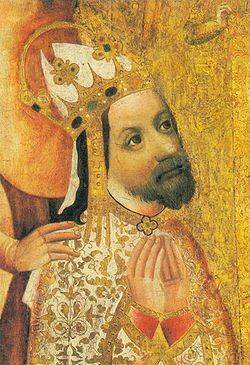
Obsah
Obsah
Portál

Full establishment of Christian culture in the Czech lands characterizes the reign of Charles IV, the Holy Roman Emperor and the Czech King. From 'Christianity in the Czech Lands' by Jan Royt
The reign of Charles IV was marked by political strength and a blossoming of the arts in the Czech lands. Charles's archbishop, Arnošt of Pardubice, helped consolidate the growth in power and glory of Charles's reign. In 1344, while John of Luxembourg, Charles's father, was still on the throne, Pope Clement VI removed the Prague and Olomouc dioceses from the authority of the Mainz archbishopric and raised Prague to an archbishopric. Shortly after becoming archbishop, Arnošt consecrated the foundation stone for Saint Vitus Cathedral in the presence of John of Luxembourg and Charles. Charles would later designate it as the burial place of the kings of Bohemia. In 1347 Arnošt crowned Charles IV as king of Bohemia and Blanche of Valois as his queen in the basilica of Saint Vitus. The same year Charles founded the Carmelite monastery, Our Lady of the Snows, and brought Slavonic Benedictines to Prague for the Emauzy Abbey, where they renewed the Slavonic liturgy. The Ambrosians he brought to the Abbey by the Powder Tower introduced the Ambrosian rite, a non-Roman rite that had been developed by Saint Ambrose of Milan in the fourth century.
Charles IV and Arnošt made Prague into a 'second Rome' by gathering a great quantity of relics of saints that, from 1352, were regularly shown with the imperial relics to assembled pilgrims in the Corpus Christi Chapel. Charles greatly revered the Czech patron saints. To the traditional group (Wenceslas, Vitus, Procopius, Adalbert, and Ludmila), he added the King of Burgundy, Sigismund. Wenceslas, on whose skull the crown of Bohemia was supposed constantly to rest, enjoyed the greatest honor. His reliquary crown, which contains a thorn from Christ's crown of thorns, was considered the property of Saint Wenceslas for all time; rulers could only borrow it. The term 'the Lands of the Czech Crown' or 'of the Crown of Saint Wenceslas' became a term of constitutional law.
Among the most important of Charles's acts were the foundation of the abbey of Augustinian canons, Na Karlově, dedicated to Charlemagne, who was favored by Charles, and the construction of Karlštejn Castle with its superb Chapel of the Holy Rood. Designed for the protection of the crown jewels and the holiest relics of the empire, the chapel was decorated with frescos and 129 pictures of saints from the workshop of Master Theodoric.
It can generally be said that Charles's success in government was achieved by the harmony of secular and spiritual powers, but late in his reign this balance broke down. Archbishop Arnošt's efforts clashed with the fiscalism of the papal curia. In addition, at the very end of his life, the preachings of the Austrian Augustinian, Konrad Waldhauser, which pilloried all the shortcomings of the church, spread through the Czech lands. In 1364 Arnošt of Pardubice died, shortly after he had been considered for election as pope by certain cardinals. His successor, Jan Očko of Vlašim, was the papal legate for the bishoprics of Regensburg, Bamberg, and Meissen. In 1378 he was made a cardinal.
Waldhauser's 'successor' in the reform movement was Jan Milíč of Kroměříž, who established the 'Jerusalem,' a refuge for 'fallen women,' in the Old Town of Prague. Milíč continued to criticize the church and crown; once, in a sermon given in the presence of the emperor, he called Charles IV the Antichrist. Shortly before Charles's death in1378, the French cardinals refused to acknowledge the election of Urban VI as pope and elected an antipope, Clement VII. This papal schism opened the Church to criticism and fueled ideas of reform among members of,the clergy. Charles's son, Václav IV, succeeded to the throne of Bohemia, but he could not maintain the balance between church and state that his father had. After initial concord between the king and his archbishop Jan of Jenštejn, their disputes began to multiply and in 1393 came to a climax with the murder of the archbishop's vicar-general, John of Nepomuk, by the king's forces. The archbishop, who did not find support among the leaders of the church, fled to Rome, where he submitted a complaint to the pope about the king. He died in Rome before receiving a reply. Under Zbyněk of Hasenburk, archbishop from 1403 to 1411, this crisis deepened. At the head of the reform movement were several professors and students of the university, in particular Matěj of Janov and John Huss. Another sign of change was the translation of the entire Bible into Czech at the end of the fourteenth century. Several copies of this version have been preserved, including the Dresden-Leskovec Bible and the Olomouc Bible.
